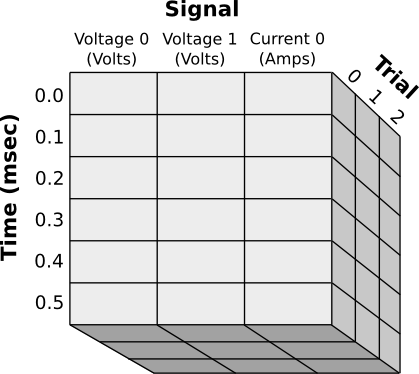MetaArray
MetaArray is a class that extends ndarray, adding support for per-axis meta data storage. This class is useful for storing data arrays along with units, axis names, column names, axis values, etc. MetaArray objects can be indexed and sliced arbitrarily using named axes and columns.
Download here: MetaArray.py
Example Uses
Here is an example of the type of data one might store with MetaArray:

Notice that each axis is named and can store different types of meta information:
- The Signal axis has named columns with different units for each column
- The Time axis associates a numerical value with each row
- The Trial axis uses normal integer indexes
Data from this array can be accessed many different ways:
data[0, 1, 1] data[:, "Voltage 1", 0] data["Trial":1, "Signal":"Voltage 0"] data["Time":slice(3,7)]
Features
- Per axis meta-information:
- Named axes
- Numerical values with units (e.g., "Time" axis above)
- Column names/units (e.g., "Signal" axis above)
- Indexing by name:
- Index each axis by name, so there is no need to remember order of axes
- Within an axis, index each column by name, so there is no need to remember the order of columns
- Read/write files easily
- Append, extend, and sort convenience functions
Documentation
Instantiation
- Accepted Syntaxes:
# Constructs MetaArray from a preexisting ndarray and info list MetaArray(ndarray, info) # Constructs MetaArray using empty(shape, dtype=type) and info list MetaArray((shape), dtype=type, info) # Constructs MetaArray from file written using MetaArray.write() MetaArray(file='fileName')
info parameter: This parameter specifies the entire set of meta data for this MetaArray and must follow a specific format. First, info is a list of axis descriptions:
info=[axis1, axis2, axis3...]
- Each axis description is a dict which may contain:
- "name": the name of the axis
- "values": a list or 1D ndarray of values, one per index in the axis
- "cols": a list of column descriptions [col1, col2, col3,...]
- "units": the units associated with the numbers listed in "values"
- "name": the name of the column
- "units": the units for all values under this column
MetaArray((3, 6, 3), dtype=float, info=[
{"name": "Signal", "cols": [
{"name": "Voltage 0", "units": "V"},
{"name": "Voltage 1", "units": "V"},
{"name": "Current 0", "units": "A"}
]
},
{"name": "Time", "units": "msec", "values":[0.0, 0.1, 0.2, 0.3, 0.4, 0.5] },
{"name": "Trial"},
{"note": "Just some extra info"}
]
Accessing Data
Data can be accessed through a variety of methods:
- Standard indexing--You may always just index the array exactly as you would any ndarray
- Named axes--If you don't remember the order of axes, you may specify the axis to be indexed or sliced like this:
data["AxisName":index] data["AxisName":slice(...)]
- Note that since this syntax hijacks the original slice mechanism, you must specify a slice using slice() if you want to use named axes.
- Column selection--If you don't remember the index of a column you wish to select, you may substitute the column's name for the index number. Lists of column names are also acceptable. For example:
data["AxisName":"ColumnName"] data["ColumnName"] ## Works only if the named column exists for this axis data[["ColumnName1", "ColumnName2"]]
- Boolean selection--works as you might normally expect, for example:
sel = data["ColumnName", 0, 0] > 0.2 data[sel]
Access axis values using MetaArray.axisValues(), or .xvals() for short.
- Access axis units using .axisUnits(), column units using .columnUnits()
- Access any other parameter directly through the info list with .infoCopy()
File I/O
data.write('fileName')
newData = MetaArray(file='fileName')
Performance Tips
MetaArray is a subclass of ndarray which overrides the __getitem__ and __setitem__ methods. Since these methods must alter the structure of the meta information for each access, they are quite slow compared to the native methods. As a result, many builtin functions will run very slowly when operating on a MetaArray. It is recommended, therefore, that you recast your arrays before performing these operations like this:
data = MetaArray(...) data.mean() ## Very slow data.view(ndarray).mean() ## native speed
More Examples
- A 2D array of altitude values for a topographical map might look like
info=[
{'name': 'lat', 'title': 'Latitude'},
{'name': 'lon', 'title': 'Longitude'},
{'title': 'Altitude', 'units': 'm'}
]- In this case, every value in the array represents the altitude in feet at the lat, lon position represented by the array index. All of the following return the value at lat=10, lon=5:
array[10, 5]
array['lon':5, 'lat':10]
array['lat':10][5]- Now suppose we want to combine this data with another array of equal dimensions that represents the average rainfall for each location. We could easily store these as two separate arrays or combine them into a 3D array with this description:
info=[
{'name': 'vals', 'cols': [
{'name': 'altitude', 'units': 'm'},
{'name': 'rainfall', 'units': 'cm/year'}
]},
{'name': 'lat', 'title': 'Latitude'},
{'name': 'lon', 'title': 'Longitude'}
]- We can now access the altitude values with array[0] or array['altitude'], and the rainfall values with array[1] or array['rainfall']. All of the following return the rainfall value at lat=10, lon=5:
array[1, 10, 5]
array['lon':5, 'lat':10, 'val': 'rainfall']
array['rainfall', 'lon':5, 'lat':10]- Notice that in the second example, there is no need for an extra (4th) axis description since the actual values are described (name and units) in the column info for the first axis.
Contact
Luke Campagnola - lcampagn@email.unc.edu